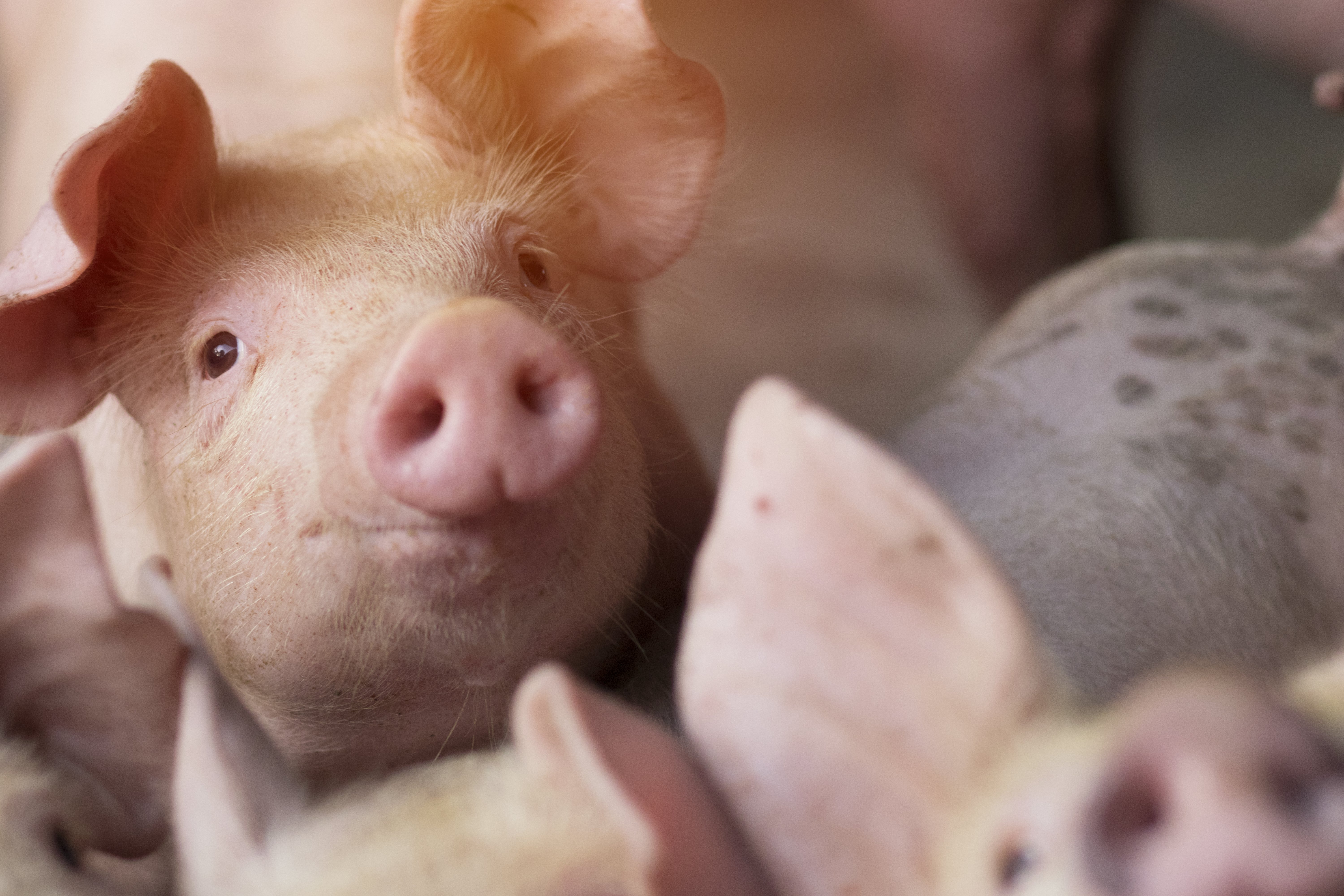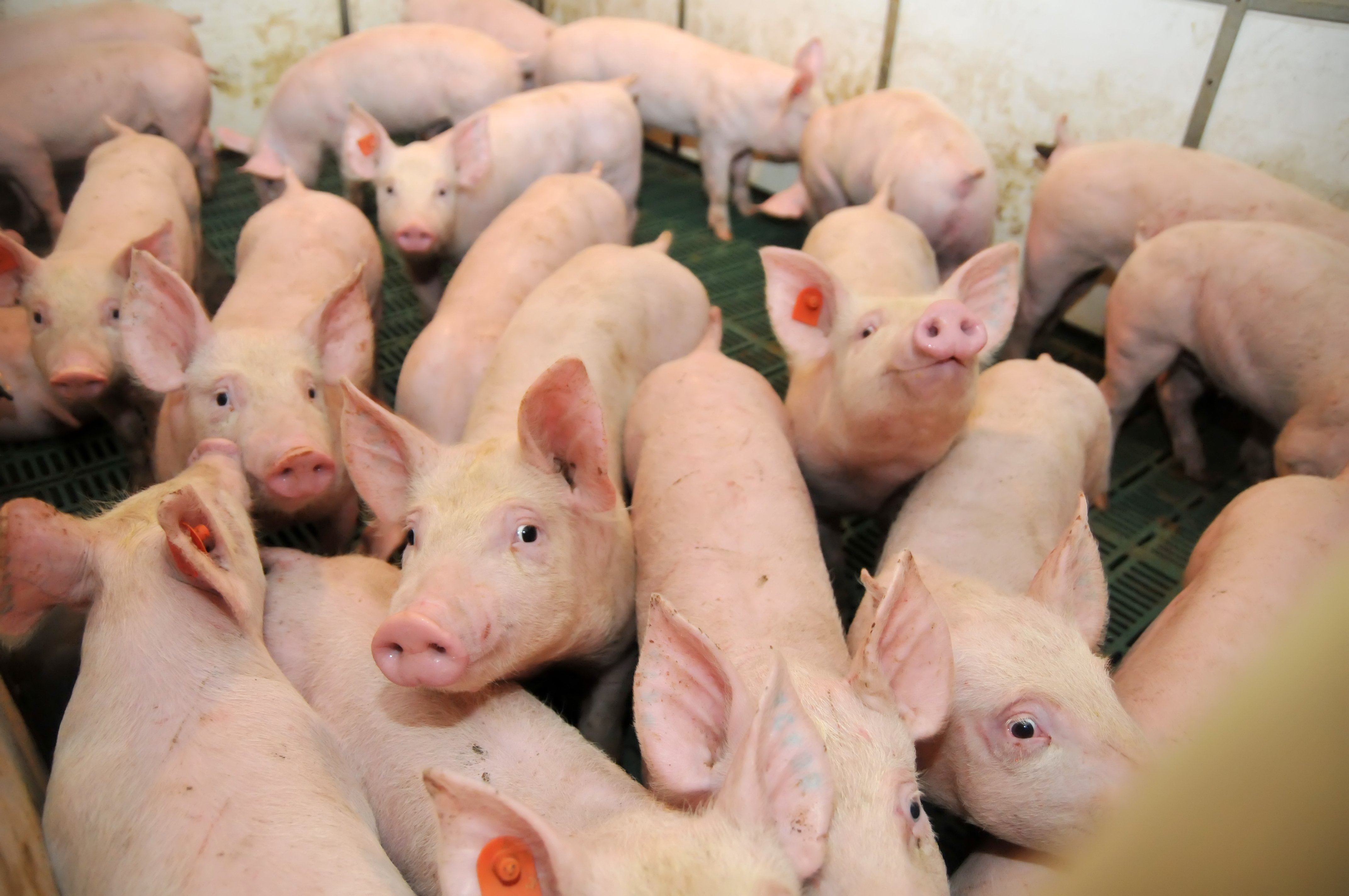14 March 2023
Why has the use of ZnO been banned in the EU?
Why has the use of ZnO been banned in the EU?
-
The risk (non-quantifiable at present) of the selection of multiple antimicrobial resistance genes associated with the use of ZnO.
-
The absence of measures identified as effective in managing environmental zinc accumulation.
The consequences of ZnO on the intestinal flora of weaned pigs

ZnO primarily enhances voluntary feed intake of nursery pigs.
Issues feeding piglets with ZnO
Issues feeding piglets with ZnO
Increases the proportion of multi-resistant E. coli
Bednorz et al. (2013) observed that the proportion of multi-resistant E. coli was significantly increased in the ZnO group compared to the control (18.6% vs. 0%).
What is happening with edema disease?
What is happening with edema disease?
How to manage pig production without ZnO?
How to manage pig production without ZnO?
Probiotics
Probiotics are live microorganisms that improve or restore the gut microbiota when administered in adequate amounts.
The most common probiotics used in pig production belong to the genera Bacillus, Bifidobacterium, Clostridium, Enterococcus, and Lactobacillus.
However, Canibe et al. (2022) claimed that observed effects on PWD are often marginal and the vast variation in experimental conditions, detection methods, and markers measured to monitor probiotic effects on piglet health makes it difficult to compare results adequately and draw generalized conclusions on the use of probiotics as an adequate alternative.
Plants and plant extracts
Also named phytogenic compounds, they are among the often-investigated and debated alternatives to antibiotics and ZnO for preventing PWD in piglets.
This group included dried plant material and extracts (essential oils or tannins), alone or combined with other compounds such as organic acids.
However, it must be considered that various interactions between different compounds may affect their mode of action. Moreover, a side effect of essential oils, for example, is their intrinsic odor and flavor, potentially affecting feed palatability.
In the case of tannins, among the more promising antimicrobial plant compounds as alternatives to antibiotics and ZnO, only a few published in vivo studies have addressed PWD directly.
Acids
Adding organic acids: citric, fumaric, lactic, propionic, benzoic, and formic acids to weaned pigs' diets or drinking water has shown beneficial effects in the gastrointestinal tract.
Organic acids alone or in mixtures with lactic acid are widely added to weaner diets and are considered a tool to reduce the risk of PWD.
However, multiple combinations and forms of these compounds call for further investigation to assess their effectiveness.
Milk replacers and milk components
These products aim to achieve the digestive system's optimal development and health.
The studies presented by Canibe et al. (2022) have demonstrated the beneficial effects of providing milk replacer/milk products on parameters defining gut health and immunity. However, most studies did not investigate the impact of these effects on preventing PWD, which needs to be explored.

There are some options for handling PWD without the use of ZnO.
Protein level
A low dietary crude protein level has been shown to lower the frequency of diarrhea in pigs due to lower microbial protein fermentation in the colon and improved conditions in the small intestine after weaning. It has been demonstrated by Batson et al. (2021), Larsen et al. (2021), and Lynegaard et al. (2021).
Moreover, one of the first actions taken after the onset of the edema disease is to implement a certain feeding restriction at weaning, trying to minimize the effects of the special energy and protein diet provided at this stage (elevation of intestinal pH, which favors growth of E. coli).
Creep feed
Piglets consuming feed during the lactation phase will eat more after weaning. One of the purposes of feeding creep feed is to "train" the digestive tract to produce enzymes to cope with the post-weaning situation.
However, Canibe et al. (2022) affirmed that studies had shown a high variation in creep feed consumption.
Vaccines
ETEC infections are non-invasive, and the active induction of mucosal immunity is significant for achieving protection against PWD. There are different options, such as live oral vaccines for piglets.
For edema disease, it must be taken into account that intramuscular antibiotics can even worsen the condition by causing the massive release of toxins by acting on the bacteria. Therefore, toxoid vaccines, specifically designed to act on the toxin, are an effective alternative to the use of antibiotics on farms.
One of them are Shiga toxin toxoid vaccines. A single application to piglets from the 4th day of life generates an immunization that persists and protect piglets during the entire sensitive period of life of the piglets and that reduces mortality and clinical signs of the edema disease caused during transition and fattening period. Positive effect of the vaccination was described also in case of subclinical ED.
Management
Reviewing the basic management concepts at the herd level is one of the main points for reducing the levels of stress in the piglets, especially in the weaning and post-weaning phases.
The 20 points plan from Madec is a good starting point.
Hygiene, environmental conditions, and facilities are other vital aspects to consider for the piglets' well-being at this critical moment in their productive life.
Conclusions
Conclusions
References
AHBD Pork. Removing zinc oxide from pig diets. https://ahdb.org.uk/knowledge-library/removing-zinc-oxide-from-pig-diets.
Barth, S.A., Bauerfeind, R., Berens, C. & Menge, C. (2021). Shiga Toxin-Producing E. coli in Animals: Detection, Characterization, and Virulence Assessment. Methods in Molecular Biology, 2291:19-86. doi: 10.1007/978-1-0716-1339-9_2. PMID: 33704748.
Batson, K.L., Calderón, H.I., Tokach, M.D., Woodworth, J.C., Goodband, R.D., Dritz, S.S. & DeRouchey, J.M. (2021). Effects of feeding diets containing low crude protein and coarse wheat bran as alternatives to zinc oxide in nursery pig diets. Journal of animal science, 99(5), skab090. https://doi.org/10.1093/jas/skab090.
Bednorz, C., Oelgeschläger, K., Kinnemann, B., Hartmann, S., Neumann, K., Pieper, R., Bethe, A., Semmler, T., Tedin, K., Schierack, P., Wieler, L.H. & Guenther, S. (2013). The broader context of antibiotic resistance: Zinc feed supplementation of piglets increases the proportion of multi-resistant Escherichia coli in vivo. International Journal of Medical Microbiology, 303, 6–7, 396-403.
Bonetti, A., Tugnoli, B., Piva, A. & Grilli, E. (2021). Towards Zero Zinc Oxide: Feeding Strategies to Manage Post-Weaning Diarrhea in Piglets. Animals 11(3), 642. https://doi.org/10.3390/ani11030642.
Burrough, E.R., De Mille, C. & Gabler, N.K. (2019). Zinc overload in weaned pigs: tissue accumulation, pathology, and growth impacts. Journal of Veterinary Diagnostic Investigation, 31(4). https://doi.org/10.1128/AEM.04283-13.
Canibe, N., Højberg, O., Kongsted, H., Vodolazska, D., Lauridsen, C., Nielsen, T.S. & Schönherz, A.A. (2022). Review on Preventive Measures to Reduce Post-Weaning Diarrhoea in Piglets. Animals 12(19), 2585. https://doi.org/10.3390/ani12192585.
Casanova, N.A., Redondo, L.M., Dailoff, G.C., Arenas, D. & Fernández Miyakawa, M.E. (2018). Overview of the role of Shiga toxins in porcine edema disease pathogenesis. Toxicon, 15;148:149-154. doi: 10.1016/j.toxicon.2018.04.019. PMID: 29698757.
Castro, J., Barros, M.M., Araújo, D., Campos, A.M., Oliveira, R., Silva, S. & Almeida, C. (2022). Swine enteric colibacillosis: Current treatment avenues and future directions. Frontiers in veterinary science, 9, 981207. https://doi.org/10.3389/fvets.2022.981207.
Christensen, B., Zhu, C., Mohammadigheisar, M., Schulze, H., Huber, L.A. & Kiarie, E.G. (2022). Growth performance, immune status, gastrointestinal tract ecology, and function in nursery pigs fed enzymatically treated yeast without or with pharmacological levels of zinc. Journal of animal science, 100(4), skac094. https://doi.org/10.1093/jas/skac094.
De Mille, C.M., Burrough, E.R., Kerr, B.J., Schweer, W.P. & Gabler, N.K. (2022). Dietary Pharmacological Zinc and Copper Enhances Voluntary Feed Intake of Nursery Pigs. Frontiers in veterinary science, 3, 874284. doi: 10.3389/fanim.2022.874284.
Eriksen, E.Ø., Pedersen, K.S., Larsen, I. & Nielsen, J.P. (2022). Evidence-Based Recommendations for Herd Health Management of Porcine Post-Weaning Diarrhea. Animals, 12(14), 1737. http://dx.doi.org/10.3390/ani12141737.
Fricke, R., Bastert, O., Gotter, V., Brons, N., Kamp, J. & Selbitz, H.J (2015). Implementation of a vaccine against Shigatoxin 2e in a piglet producing farm with problems of Oedema disease: case study. Porcine Health Management, 7;1:6. doi: 10.1186/2055-5660-1-6. PMID: 28405415; PMCID: PMC5375124.
Højberg, O., Canibe, N., Poulsen, H.D., Hedemann, M.S. & Jensen, B.B. (2005). Influence of dietary zinc oxide and copper sulfate on the gastrointestinal ecosystem in newly weaned piglets. Applied and environmental microbiology, 71(5), 2267–2277. https://doi.org/10.1128/AEM.71.5.2267-2277.2005.
Juhász, Á., Molnár-Nagy, V., Bata, Z., Tso, K.H., Mayer, Z. & Posta, K. (2022). Alternative to ZnO to establish balanced intestinal microbiota for weaning piglets. PloS one, 17(3), e0265573. https://doi.org/10.1371/journal.pone.0265573.
Katouli, M., Melin, L., Jensen-Waern, M., Wallgren, P. & Möllby, R. (2001). The effect of zinc oxide supplementation on the stability of the intestinal flora with special reference to composition of coliforms in weaned pigs. Journal of Applied Microbiology 87(4). https://doi.org/10.1046/j.1365-2672.1999.00853.x.
Larsen, C., Lynegaard, J.C., Pedersen, A.Ø., Kjeldsen, N.J., Hansen, C.F., Nielsen, J.P. & Amdi, C. (2021). A reduced CP level without medicinal zinc oxide does not alter the intestinal morphology in weaned pigs 24 days post-weaning. Animal, 15(4). https://doi.org/10.1016/j.animal.2021.100188.
Lynegaard, J.C., Kjeldsen, N.J., Bache, J.K., Weber, N.R., Hansen, C.F., Nielsen, J.P. & Amdi, C. (2021). Low protein diets without medicinal zinc oxide for weaned pigs reduced diarrhea treatments and average daily gain. Animal, 15(1). https://doi.org/10.1016/j.animal.2020.100075.
Medardus, J.J., Molla, B.Z., Nicol, M., Morrow, W.M., Rajala-Schultz, P.J., Kazwala, R. & Gebreyes, W.A. (2014). In-Feed Use of Heavy Metal Micronutrients in U.S. Swine Production Systems and Its Role in Persistence of Multidrug-Resistant Salmonellae. Applied and Environmental Microbiology, 80(7). https://doi.org/10.1128/AEM.04283-13.
Nielsen, C.L., Krogh, M.A., Sørensen, J.T. & Kongsted, H. (2022). A field trial on the effect of cross-fostering and weaning age on daily gain and disease resilience in weaned pigs. Preventive Veterinary Medicine, 208, 105762. https://doi.org/10.1016/j.prevetmed.2022.105762.
Nielsen, T.S., Engelsmann, M.N., Hansen, S.V. & Maribo, H. (2022). Bioavailability of Different Zinc Sources in Pigs 0-3 Weeks Post-Weaning. Animals 12(21), 2921. https://doi.org/10.3390/ani12212921.
Pig Progress (2018). The six different roles of zinc in pigs. https://www.pigprogress.net/health-nutrition/the-six-different-roles-of-zinc-in-pigs/.
Pig Progress (2018). 5 reasons why banning zinc oxide is good. https://www.pigprogress.net/health-nutrition/5-reasons-why-banning-zinc-oxide-is-good/.
Pig Progress (2019). Benefits of ZnO nanoparticles in piglet diets. https://www.pigprogress.net/specials/benefits-of-zno-nanoparticles-in-piglet-diets/.
Rhouma, M., Fairbrother, J.M., Beaudry, F. & Letellier, A. (2017). Post weaning diarrhea in pigs: risk factors and non-colistin-based control strategies. Acta Vet Scandinavia 59(31). https://doi.org/10.1186/s13028-017-0299-7.
Sjölund, M., Zoric, M. & Wallgren, P. (2014). Financial impact on pig production: III. Gastrointestinal disorders. Conference: The 6th European Symposium of Porcine Health Management. At: Sorrento, Italy.
Starke, I.C., Pieper, R., Neumann, K., Zentek, J. & Vahjen, W. (2014). The impact of high dietary zinc oxide on the development of the intestinal microbiota in weaned piglets. FEMS Microbiology Ecology, 87(2), 416–427. https://doi.org/10.1111/1574-6941.12233
The Pig Site (2002). UPDATE: Practical methods for controlling PMWS. https://www.thepigsite.com/articles/update-practical-methods-for-controlling-pmws.
The Pig Site (2019). Zero ZnO: why we need to replace zinc oxide in tackling post-weaning diarrhea. https://www.thepigsite.com/news/2019/11/zero-zno-why-we-need-to-replace-zinc-oxide-in-tackling-post-weaning-diarrhoea.
University of Minnesota. Edema disease - F18 Escherichia coli. https://open.lib.umn.edu/swinedisease/chapter/edema-disease/
WATTPoultry (2013). Five possible negative effects of zinc oxide on piglets. https://www.wattagnet.com/articles/17695-five-possible-negative-effects-of-zinc-oxide-on-piglets.
Zimmerman, J. J., Karriker, L. A., Ramírez, A., Schwartz, K. J. & Stevenson, G. (2012). Disease of Swine, 10th edition. ISBN 978-0-8138-2267-9.
Zinc oxide, (n.d.). European Medicines Agency. https://www.ema.europa.eu/en/medicines/veterinary/referrals/zinc-oxide.
